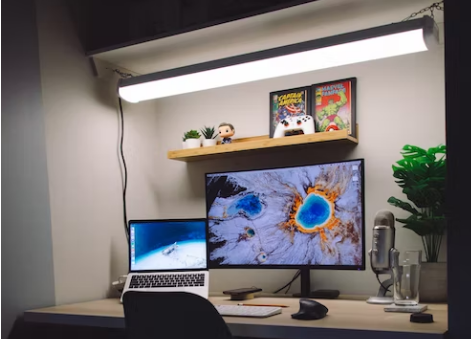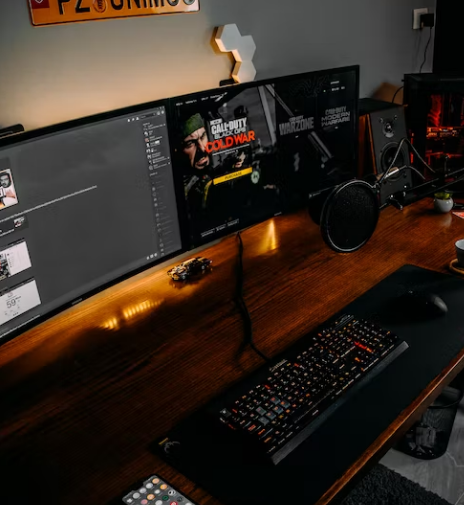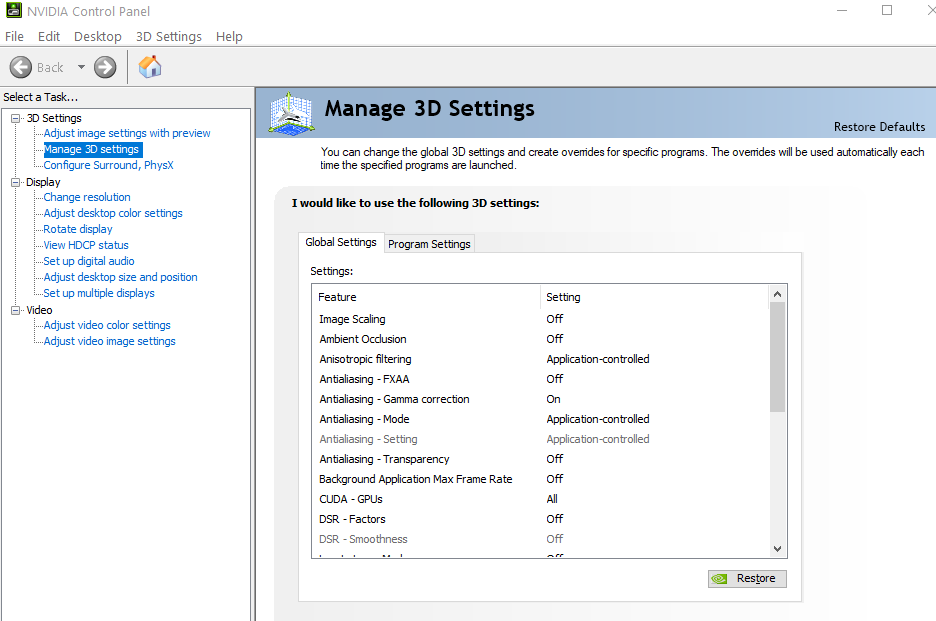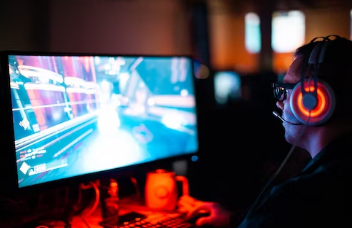As a modern-day gamer, you want to ensure that you have the best possible visual experience when indulging in your favorite games. To enable the best possible visual, it is highly likely that you will be enticed to choose a monitor which uses AMD Freesync technology.
Freesync monitors provide an adaptable refresh rate. Opposite to your traditional monitor which operates only at a fixed refresh rate. By having the ability to adapt the refresh rate to vary alongside the output of your GPU, screen-tearing will be greatly reduced.

The overall graphical display of your games will be greatly improved. This variable refresher rate will enhance your gaming experience by providing a wonderfully smooth and sharp visual at all times. You may wish to use your new Freesync Monitor in tandem with your system’s NVidia graphics card.
This is where many users encounter some difficulty. Here we will outline how to overcome this issue and get both working smoothly together.
What is G-Sync?
Simply put, G-sync is the technology that is used by monitors to synchronize their refresh rate to the refresh rate produced by the GPU. This particular G-sync technology is patented by NVIDIA.
The benefits of this feature are the elimination of screen tearing and the minimization of stuttering. Normally, to avoid screen tearing and stuttering, you could enable V-sync. However, this will lock the frame rate to a certain refresh rate.
So it will not offer the best gameplay experience. However, with G-Sync-enabled monitors and Nvidia GPUs, you can get the best gameplay experience.
To be noted, to incorporate the G-sync technology on their monitors, the manufacturer should get a license from NVIDIA.
That is why monitors with G-Sync technology tend to be a bit pricey. Also, this makes the monitor manufacturers make high-end monitors as per NVIDIA’s instructions.
What is FreeSync?
Fressync is almost the same thing as G-sync. But it is an AMD technology. Also, it is a royalty-free technology. That means monitor manufacturers don’t require a licensing deal from AMD to use this technology on their monitors.
This makes the price of the monitors with AMD FreeSync a bit lower. However, it also means that the AMD Freesync technology is used on some low-end monitors as well.
Why Combine Your Freesync Monitor with NVidia Graphics Card
This may be the most obvious question on the lips of many. Freesync is a royalty free and open technology developed by AMD. This openness and licensing free approach from AMD mean that you will find Freesync implemented in a much wider range of monitors.

Furthermore, at a much more affordable price than the much stricter G-Sync over which NVidia retains tight proprietary control.
The fact that both technologies offer vastly similar benefits mean that you are very likely encounter this dilemma of combining your existing systems NVidia graphics card with your Freesync monitor. Rest easy, it can be done and we will explain how.
How to use Freesync with NVidia
In 2019, NVIDIA started to support AMD FreeSync monitors to use variable refresh rate features with their GEFORCE GTX graphics cards. There were a number of requirements thrown out by NVIDIA though. We will talk about them in the next section.
And if you have a system that meets all the requirements then you will be able to combine your FreeSync monitor with the NVIDIA G-Sync GPU without any problem. And if your monitor or system doesn’t meet the requirement. Still, you will be able to use the monitor. However, you will not be able to use the active sync.
Requirements
You can use the FreeSync feature with your NVIDIA GPU. However, there are a few requirements you should meet. First of all, your monitor needs to have a DisplayPort 1.2 port. And you have to connect your monitor to the NVIDIA GPU using that DisplayPort 1.2 port.
However, if you have a high-end GPU like the NVIDIA GeForce RTX 2080 Ti, then you can use the HDMI port as well. Next, your monitor should pass a full-screen test. In addition, it should also support at least 30 Hz at a 2560×1440 screen resolution. You will also need the latest graphics driver.
On top of that, your monitor should obviously support AMD FreeSync. If your system meets all these requirements, then you are good to go to combine your FreeSync monitor with your NVIDIA graphics card.
Enable G-Sync
Once you are sure that your system meets all the requirements mentioned above, you can proceed to the next step. The next step is to install the latest graphics driver for your NVIDIA GPU and enable the G-Sync feature.

So you should go to the official website of NVIDIA and download the latest driver for your particular GPU. Next, you have to install it on your PC. After that, you will be able to enable the G-Sync feature. Here’s how to do it…
Steps to Follow
- Open the NVIDIA Control Panel tool on your PC. You should Right-click on the empty desktop. Then click on the NVIDIA Control Panel option from there
- Next, you have to click on the Display option from the left sidebar
- After that, you will have to click on the Set up G-sync option that will be under Display in the Setup G-sync section
- Then you have to click on Enable G-sync option
- Next, you need to click on the Apply option or Enable settings option
- After that, you will need to click on the checkbox next to the ‘Enable for full-screen mode’ option
That is it. You have enabled G-sync on your PC. Now, you should see this feature on effect while you play new games.
Is it actually worth it?
Now that we have identified it is possible to operate your Freesync monitor in combination with an NVidia graphics card without issue, we reach the inevitable question of, is it worth it?
Simply put, there are no drawbacks. As we discussed above, the Freesync offers high-end technology at a very good price if you are looking to beef up your monitor specs. Also, NVIDIA now supports FreeSync monitors. So it is definitely worth it.
For the vast majority of gamers, it will provide awesome performance with no noticeable drawback at all. Those operating extremely graphic intensive games such as those we have mentioned will want to research further and consider their options to maintain optimal performance.
For some of the unluckiest of you, you might be losing the Freesync functionality of the monitor. Therefore, you really just have to question if you should change your monitor at all.
However, with the improved technology available at such a great price and if you are thinking about changing your monitor anyway, then it is certainly a valuable investment.
Types of Monitors that Support Adaptive Sync with Nvidia GPU
We have said that you can use AMD FreeSync monitors with NVIDIA GPUs. But it is not available for all types of monitors.
Rather, when NVIDIA announced that they would support FreeSync monitors, they actually listed the names of 28 monitors that would perfectly support the feature. That means, if you have one of those monitors, you will not have to do anything to use FreeSync with the Nvidia GPU.

It would have been plug-and-play. So once you have connected your monitor to the GPU, the G-Sync would be enabled automatically.
However, lucky for you, there are many monitors that are not on that list by NVIDIA that are compatible with the FeeSync feature. So it is better to try it for yourself and see whether your monitor works or not.
Remember, whether your monitor is compatible with this feature, it will work as a normal monitor all the time. That means even if your AMD FreeSync monitor is not supporting variable refresh rates with the NVIDIA GPU, it will work as a normal monitor without any problem. You will just miss the G-sync feature.
Other Options Available
You also have a variety of other options available when it comes to upgrading and combining with your new Freesync monitor.
Upgrading to a Freesync monitor in itself represents a good value future investment. You could consider it a stepping stone to future upgrades or simply to have an updated and powerful monitor.
You could also use it as an opportunity to combine with an AMD GPU in the future. This is a very powerful and price effective choice which would ensure you will benefit from all the possible performance features of the Freesync.
And as you know that NVIDIA made the G-Sync feature available for everyone, so you should check whether your monitor supports it or not.
Chances are, your AMD FreeSync monitor would be compatible with your NVIDIA graphics card.
3 Reasons to Upgrade to a G-sync monitor.
AMD and NVidia are direct competitors so it only makes sense that they would make gaming monitors specific to their products.
Here are a few reasons why you should skip the hassle altogether and upgrade to a G-sync monitor for your NVidia graphics card:
Eliminate screen tearing
Screen tearing is when a video display shows a visual artifact from multiple frames in one screen draw. The main reason why this happens is that the video feed is not in synchronization with the monitor’s refresh rate.
NVidia was the first to recognize and create a proprietary solution to this problem. It solves the issue with the G-sync technology by forcing the video display to measure up to the framerate of the graphics card.
G-sync is an elegant technology that is patented which means no other company can use/re-produce it without NVidia’s permission
Royalty-Paid = Higher quality manufacturing
As mentioned, G-sync is a patented technology, and NVidia charges a royalty for manufacturers that wish to develop and sell monitors that incorporate the G-sync functionality.
This is one of the reasons why prices for G-sync monitors are marked up higher than its AMD competitor.

One of the main reasons why NVidia’s licensing structure protects its end-users is because it can implement performance penalties for manufacturers that choose to create an inferior product using their G-sync technology.
There are affordable options
Buying a G-sync does not mean you need to fork out 1000 dollars to get started with an excellent gaming setup. In fact, deals and sales are going on every day and you can get an excellent monitor for around $500.
Conclusion
It is fortunate that NVidia has started supporting FreeSync monitors, there is a way to achieve full harmony in performance between the Freesync and an NVidia GPU. However, as we have discussed, Freesync still provides a fantastic value monitor upgrade.
This keeps you on the cutting edge of visual performance. You are one step away from a number of future upgrade opportunities. With the correct research on the required game and system specs. this can be a fantastic investment.
Check out the wealth of top-quality Freesync monitors available on Amazon starting at an extremely affordable price point.